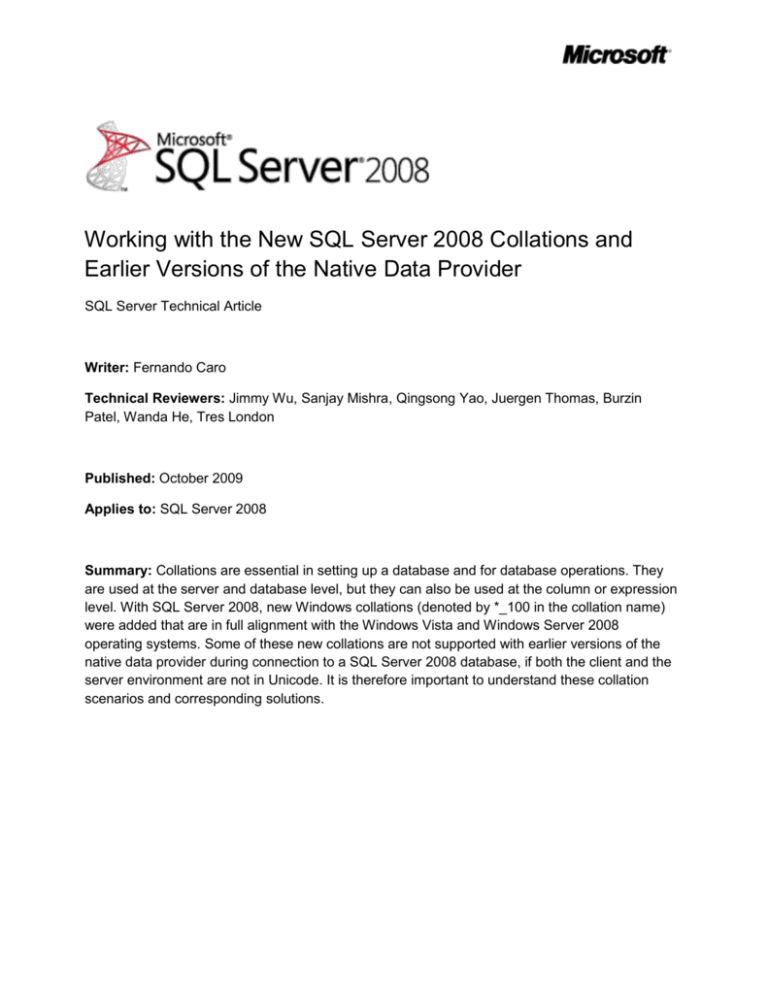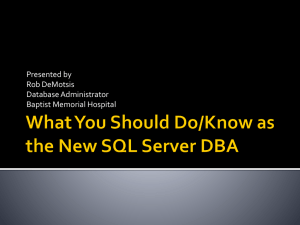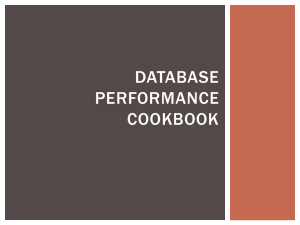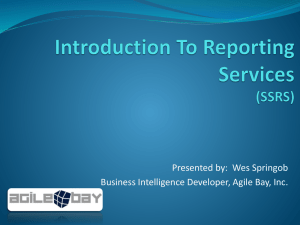
Working with the New SQL Server 2008 Collations and
Earlier Versions of the Native Data Provider
SQL Server Technical Article
Writer: Fernando Caro
Technical Reviewers: Jimmy Wu, Sanjay Mishra, Qingsong Yao, Juergen Thomas, Burzin
Patel, Wanda He, Tres London
Published: October 2009
Applies to: SQL Server 2008
Summary: Collations are essential in setting up a database and for database operations. They
are used at the server and database level, but they can also be used at the column or expression
level. With SQL Server 2008, new Windows collations (denoted by *_100 in the collation name)
were added that are in full alignment with the Windows Vista and Windows Server 2008
operating systems. Some of these new collations are not supported with earlier versions of the
native data provider during connection to a SQL Server 2008 database, if both the client and the
server environment are not in Unicode. It is therefore important to understand these collation
scenarios and corresponding solutions.
Copyright
This is a preliminary document and may be changed substantially prior to final commercial
release of the software described herein.
The information contained in this document represents the current view of Microsoft Corporation
on the issues discussed as of the date of publication. Because Microsoft must respond to
changing market conditions, it should not be interpreted to be a commitment on the part of
Microsoft, and Microsoft cannot guarantee the accuracy of any information presented after the
date of publication.
This white paper is for informational purposes only. MICROSOFT MAKES NO WARRANTIES,
EXPRESS, IMPLIED, OR STATUTORY, AS TO THE INFORMATION IN THIS DOCUMENT.
Complying with all applicable copyright laws is the responsibility of the user. Without limiting the
rights under copyright, no part of this document may be reproduced, stored in, or introduced into
a retrieval system, or transmitted in any form or by any means (electronic, mechanical,
photocopying, recording, or otherwise), or for any purpose, without the express written
permission of Microsoft Corporation.
Microsoft may have patents, patent applications, trademarks, copyrights, or other intellectual
property rights covering subject matter in this document. Except as expressly provided in any
written license agreement from Microsoft, the furnishing of this document does not give you any
license to these patents, trademarks, copyrights, or other intellectual property.
Unless otherwise noted, the example companies, organizations, products, domain names, e-mail
addresses, logos, people, places, and events depicted herein are fictitious, and no association
with any real company, organization, product, domain name, e-mail address, logo, person, place,
or event is intended or should be inferred.
© 2008 Microsoft Corporation. All rights reserved.
Microsoft, MSDN, SQL Server, Windows, Windows Server, and Windows Vista are trademarks
of the Microsoft group of companies.
All other trademarks are property of their respective owners.
2
Contents
Introduction ................................................................................................................................................... 4
General Client-to-SQL Server Collation Interaction ............................................................................... 4
Client-to-SQL Server Data Flow and Data Conversions ................................................................... 5
Collations in SQL Server 2008 .................................................................................................................. 7
What’s New in SQL Server 2008........................................................................................................... 7
Earlier Versions of the Native Data Provider ........................................................................................... 9
Collations Not Recognized by Earlier Version of the Native Data Provider.................................... 9
Native Data Provider’s Specific Behavior Scenarios .......................................................................... 9
Generic Error Message ......................................................................................................................... 10
Server-Side Error Conditions ............................................................................................................... 11
Earlier Versions of the Native Data Providers and Error Message Scenarios ............................. 11
Conclusion .................................................................................................................................................. 15
Appendix ........................................................................................................ Error! Bookmark not defined.
3
Introduction
As databases continue to expand and support a growing global market, users need to be able to
work with character data in meaningful ways and use the most up-to-date linguistic collations to
meet language market expectations.
As such, collations are a powerful way for users to sort and compare strings according to their
own cultural conventions. They play a critical part in database creation and in data operations.
The Microsoft® SQL Server® 2008 data management software introduced new Windows®
collations that are in full alignment with the Windows Vista® and Windows Server® 2008
operating systems. These new collations are denoted by *_100 in the collation name and
represent unique sort semantics that correspond with the Windows locales, though it is not
required to be running on Windows Vista or Windows Server 2008 to use these new collations.
The new SQL Server Windows collations include support for the following:
New East Asian government standards such as JIS2004 for Japan
Chinese minority scripts (Yi, Uighur, Mongolian, Tibetan)
Unicode 5.0 case table
Weights to previously nonweighted characters that would have had equal value in
comparisons
They are also linguistically correct for supplementary characters.
It should be noted that while SQL Server 2008 has introduced new Windows collations to reflect
these changes, no modifications have been made to the collations supported in SQL Server
2000 and SQL Server 2005 (though this may change in future versions in case of deprecation).
In addition, the SQL_* named collations are maintained to keep compatibility with previous
versions of SQL Server and for applications that use these collations. For more information about
collations, see “Working with Collations” (http://msdn.microsoft.com/enus/library/ms187582.aspx). For more information about Unicode, see “Unicode Basics”
(http://msdn.microsoft.com/en-us/library/ms187828.aspx). Both topics are part of SQL Server
Books Online.
This paper describes the set of scenarios and solutions when trying to connect to a SQL Server
2008 database (and both the client and the server environment are not in Unicode) and when
using one of the earlier versions of the native data provider that are interacting with an
unsupported set of the SQL Server 2008 *_100 named collations. The paper also provides
solutions for working in these scenarios.
General Client-to-SQL Server Collation Interaction
In SQL Server, collations constitute two key semantics:
4
Sort order as defined by Windows. Sort order applies to character (char/varchar) and
Unicode data types (nchar/nvarchar).
The database collation, which determines which code page is used to store the character
data used by the char and varchar character data types. Both these data types are nonUnicode.
In a client-to-SQL Server environment, collations are used by the native data providers to handle
the data conversions if the client-to-SQL Server environment is not entirely in Unicode. This is to
avoid data being improperly converted (characters would be represented as “?”).
Client-to-SQL Server Data Flow and Data Conversions
The following figures illustrate scenarios in which the native data providers must convert the data
into the corresponding code page used by SQL Server char and varchar data types or into
Unicode. In figures 1 and 2, data conversions occur when the Windows active code page on the
client and the database collation that is used to store the character data used by the char and
varchar data types are in different code pages.
Client
SQL Server
Native Data Provider
Windows
ACP 1250
Converts CP 1250 data into Unicode
and then into CP 1252
DB
Latin1 collation
CP 1252
Data Flow
Client
Figure 1: Client-to-SQL Server data flow, client and SQL Server using different code pages
Client
SQL Server
Native Data Provider
Windows
ACP 1250
Converts CP 1252 data into Unicode
and then into CP 1250
Data Flow
DB
Latin1 collation
CP 1252
Client
Figure 2: SQL Server-to-client data flow, client and SQL Server using different code pages
In figures 3 and 4, the client data is not in Unicode, but the SQL Server data is.
5
Client
SQL Server
Data Provider
Windows
ACP 1250
Converts CP 1250 data into Unicode
Data Flow
DB
Latin1 collation
Unicode
Client
Figure 3: Client-to-SQL Server data flow, client data using a code page, SQL Server using
Unicode data types
Client
SQL Server
Data Provider
Windows
ACP 1250
Converts Unicode into CP 1250 data
Data Flow
DB
Latin1 collation
Unicode
Client
Figure 4: SQL Server-to-client data flow, client data using a code page, SQL Server using
Unicode data types
In figures 5 and 6, the client data is in Unicode, and SQL Server is not.
Client
SQL Server
Data Provider
Unicode
Converts Unicode into CP 1252 data
Data Flow
DB
Latin1 collation
CP 1252
Client
Figure 5: Client-to-SQL Server data flow, client using Unicode, SQL Server using a code page
6
Client
SQL Server
Data Provider
Unicode
Converts CP 1252 data into Unicode
Data Flow
DB
Latin1 collation
CP 1252
Client
Figure 6: SQL Server-to-client to data flow, client using Unicode, SQL Server using a code page
Collations in SQL Server 2008
What’s New in SQL Server 2008
Figure 7 illustrates the collation additions in SQL Server 2000, SQL Server 2005, and SQL
Server 2008.
7
SQL Server 2000
Albanian_
Arabic_
Chinese_PRC_
Chinese_PRC_Strok
e_
Chinese_Taiwan_Bo
pomofo_
Chinese_Taiwan_St
roke_
Croatian_
Cyrillic_General_
Czech_
Danish_Norwegian_
Estonian_
Finnish_Swedish_
French_
Georgian_Modern_
Sort_
German_PhoneBoo
k_
Greek_
Hebrew_
Hungarian_
Hungarian_Technica
l_
Icelandic_
Japanese_
Japanese_Unicode_
Korean_Wansung_
Latin1_General_
Latvian_
Lithuanian_
Modern_Spanish_
Polish_
Romanian_
Slovenian_
Thai_
Traditional_Spanish
_
Turkish_
Ukrainian_
Vietnamese_
New in SQL Server
2005
Chinese_Hong_Kong
_Stroke_90_
Chinese_PRC_90_
Chinese_PRC_Stroke
_90_
Chinese_Taiwan_Bop
omofo_90_
Chinese_Taiwan_Stro
ke_90_
Indic_General_90_
Japanese_90_
Korean_90_
Kazakh_90_
Macedonian_FYROM
_90_
Syriac_90_
Tatar_90_
Uzbek_Latin_90_
Figure 7: Collations in SQL Server
8
New in SQL
Server 2008
Assamese_100_
Azeri_Cyrillic_100_
Azeri_Latin_100_
Bashkir_100_
Bengali_100_
Bosnian_Cyrillic_100_
Bosnian_Latin_100_
Breton_100_
Chinese_Simplified_Strok
e_Order_100_
Chinese_Traditional_Pinyi
n_100_
Chinese_Traditional_Stro
ke_Order_100_
Corsican_100_
Danish_Greenlandic_100
_
Dari_100_
Divehi_90_
Frisian_100_
Japanese_Bushu_Kaku
su_100_
Khmer_100_
Lao_100_
Latin1_General_100
Japanese_XJIS_100_
Maltese_100_
Maori_100_
Mapudungan_100_
Mohawk_100_
Nepali_100_
Norwegian_100_
Pashto_100_
Persian_100_
Romansh_100_
Sami_Norway_100_
Sami_Sweden_Finland_
100_
Serbian_Cyrillic_100_
Serbian_Latin_100_
Slovak_
Tamazight_100_
Tibetan_100_
Turkmen_10
0_
Uighur_100_
Upper_Sorbi
an_100_
Urdu_100_
Welsh_100_
Yakut_100_
Earlier Versions of the Native Data Provider
Collations Not Recognized by Earlier Versions of the Native Data Provider
Of the new Windows collations introduced in SQL Server 2008, the collations listed in figure 7 in
black bold italic type are not recognized by earlier versions of the native data provider during
connection to a SQL Server 2008 database if both the client and the server environment are not
in Unicode. There are several possible result cases; for example, consider the following
scenario.
Note: This can happen with Windows Server 2003 and earlier, as stated previously. It can also
happen with Windows Server 2008 and Windows Server 2008 R2.
For instance, consider a situation in which SQL Server 2005 and SQL Server 2008 are installed
side-by-side on Windows Server 2008. A SQL Server 2005 data provider, such as Microsoft SQL
Server Native Client 9.0 (SNAC9) or Windows Data Access Components (Windows DAC), is
used to connect to an instance of SQL Server 2008 that uses one of the new unsupported SQL
Server 2008 collations.
As a result of this scenario, one of the following things can happen:
A down-level client application can lose its connection with SQL Server. Specifically, if an
error message cannot be provided during the result set, the connection will be lost. For
more information, see “Generic Error Message” later in this paper.
The client connection is not lost; however, an error message will indicate that there is a
collation mismatch between the client and server data, and no data conversion of the
server data will occur.
In both cases, the connection is lost or the error message is provided if one of the new Windows
collations in SQL Server 2008 is being used, if the collation is not recognized by the earlier
version of the native data provider during connection to a SQL Server 2008 database and both
the client and server environment are not in Unicode.
This is to prevent data conversions that can produce data loss from occurring.
Native Data Provider’s Specific Behavior Scenarios
The following table illustrates the current behavior of the earlier version of the native data
provider and lists the solution.
Data provider version
SQL Native Client 10.0
(SQL Server 2008)
9
Existing behavior
Instead of SQL Native Client 9.0
existing behavior:
Uses a Windows code page if
it does not recognize the
collation.
Fails on the client if it cannot
determine the correct code
page for the data conversion.
Solution
None (no solution required).
SQL Native Client 9.0,
(Earlier than SQL Server
2008)
Windows DAC
The data provider attempts to
derive the locale and map it to
the corresponding client code
page.
If the locale identifier is not
recognized by the data
provider, the active code page
from the client machine
system locale is used for the
data conversion.
If the characters are
incorrectly mapped from the
code page to another code
page, the data conversion
may result in data loss.
The data provider attempts to
derive the locale identifier
from Windows.
If the locale identifier is not
recognized by the data
provider, the active code
page from the client machine
system locale is used for the
data conversion.
If the characters are
incorrectly mapped from the
code page to another code
page, the data conversion
may result in data loss.
Apply the hotfix located here.
Apply the update located
here.
Third-party providers such as FreeTDS, DataDirect, EasySoft, Open Link, and so on can either
continue to reverse engineer based on available published Knowledge Base articles or by using
the publically documented network protocol, [MS-TDS]: Tabular Data Stream Protocol
Specification, in the Windows Server Protocols (WSPP) section of the MSDN® Library.
Generic Error Message
The following error message is provided from the server to the client:
“The statement failed because the database collation CollationName is not recognized by
older client drivers. Try upgrading the client operating system or applying a service
update to the database client software, or use a different collation. See SQL Server
Books Online for more information on changing collations.”
The statement referenced is a USE or ALTER DATABASE statement. The message appears
during retrieval of result sets that use one of the new collations not recognized downlevel and
that contain one of the following: a sql_variant data type, a column, an output parameter, or an
output parameter using sql_variant.
10
This message appears because one of the new SQL Server 2008 Windows collations has been
passed to a downlevel client application that relies on an earlier version of the data provider such
as SNAC9 or Windows DAC. This server message also helps third-party applications that rely on
these data providers and downlevel clients that have not applied the appropriate solution.
However, some clients may be able to provide a client-side message or properly handle the data
when working with one of the new collations. When this happens, the client sets a new login
packet bit. This bit tells SQL Server not to send the error message. This means that earlier
versions of the native data provider can provide a client-side error message or properly handle
the data instead of relying on SQL Server to provide the error message.
Server-Side Error Conditions
The following table explains what happens when an earlier version of the data provider is used
and the client application cannot provide a client-side error.
Case
Result set in server-to-client downlevel for
string type (char, varchar)
SQL_VARIANT
RPC non-SQL_VARIANT output parameters
RPC SQL_VARIANT parameters
ENVCHANGE
Result
Fails with an error message sent to the client
or disconnects
Disconnects client and writes error message to
the SQL Server error log
Fails with an error message sent to the client
Disconnects from the client and writes an error
message to the SQL Server error log
Fails at login with an error message sent to the
client*
RPC input parameters (input/output)
TVP/BCP input
Input from old client (before version 7.1) that
Client data accepted**
does not send a collation with input
parameters
Old client sending a multibyte character sets
(MBCS) event in a new collation
Connection reset where the client cannot set
Fails the connection or the statement with an
the bit
error message sent to the client
*Occurs only for downlevel clients running on downlevel operating systems.
**For cases where the client data is accepted, this is specifically when the server fails the new collations
being sent to the downlevel client.
Earlier Versions of the Native Data Provider and Error Message Scenarios
This section lists scenarios in which error messages would be sent.
Scenario 1: SQL Server sends to the client a result set containing:
11
A sql_variant or char/varchar type with new collations (COLMETADATA and ROW
tokens).
A computed column of sql_variant or char/varchar type with new collations
(ALTMETADATA and ALTROW tokens).
Scenario 2: The client invokes a remote procedure call (RPC) taking an input parameter of
sql_variant or char/varchar type with new collations (RPCRequest token).
Scenario 3: The client and SQL Server exchange RPCs with an output parameter of sql_variant
or char/varchar type with new collations (RPCRequest and RETURNVALUE tokens).
Scenario 4: An ENVCHANGE occurs during:
A login statement that contains a new collation. The client requests a connection to a
database that uses a new collation during login.
A USE DB statement that contains a new collation. The client issues a USE DB
statement to a database that uses a new collation.
Scenario 5: Cached queries are encountered. A query is executed first by a client that is aware
of new collations and then by a client that is unaware of new collations.
Scenario 6: Cached RPCs are encountered. An RPC is executed first by a client that is aware of
new collations and then by a client that is unaware of new collations.
Scenario 7: An attempt is made to fetch columns of sql_variant or char/varchar types with new
collations.
Here are more explicit examples of such cases, when one of the new collations is used.
Example 1: An application that uses an earlier version of the data provider selects from a table
that contains one or more columns of sql_variant or char/varchar data types with new
collations.
Example 2: An application that uses an earlier version of the data provider selects from a table
that contains one or more columns of sql_variant or char/varchar data types with new
collations.
Example 3: An application that uses an earlier version of the data provider calls an RPC with one
or more input parameters of sql_variant or char/varchar data types with new collations.
Example 4: An application that uses an earlier version of the data provider calls an RPC with one
or more output parameters of sql_variant or char/varchar data types with new collations.
Example 5: An application that uses an earlier version of the data provider calls an RPC with one
or more input parameters of sql_variant or char/varchar data types with new collations.
Example 6: An application that uses an earlier version of the data provider calls an RPC with one
or more output parameters of sql_variant or char/varchar data types with new collations.
Example 7: An application that uses an earlier version of the data provider selects from a table
that contains one or more columns of sql_variant or char/varchar data types with new
12
collations. (The data might potentially be cached because it was recently requested by another
client.)
Example 8: An application that uses an earlier version of the data provider calls an RPC with one
or more output parameters of sql_variant or char/varchar data types with new collations. (The
data might potentially be cached because it was recently requested by another client.)
Example 9: An application that uses an earlier version of the data provider opens a cursor on a
table with one or more columns of sql_variant or char/varchar data types with new collations
and then fetches rows from this cursor.
Example 10: An application that uses an earlier version of the data provider opens a cursor on a
table with one or more columns of sql_variant or char/varchar data types with new collations
and then fetches rows from this cursor.
Query example:
CREATE TABLE tvarchar (cvc varchar(100) COLLATE Norwegian_100_CI_AS)
GO
INSERT INTO tvarchar VALUES ("MyValue1")
GO
INSERT INTO tvarchar VALUES ("MyValue2")
GO
CREATE TABLE tvariant (cvar sql_variant)
GO
SELECT * FROM tvarchar
-- For high-level (for example, a low-level client is one that uses
SNAC 9, and a high-level client is one that uses SNAC10; if you use
SNAC9 to connect to SQL Server 2008 [downlevel] and it is not patched,
13
it will fail if you are accessing data with an unsupported new SQL
Server 2008 Windows-based collation) or patched client: output
cvc
--MyValue1
MyValue2
-- For low-level unpatched client: output
The statement failed because column 'cvc' (ID=0) uses collation
Norwegian_100_CI_AS, which is not recognized by older client drivers
Try upgrading the client operating system or applying a service update
to the database client software, or use a different collation See SQL
Server Books Online for more information on changing collations.
***********************************************************************
SELECT * FROM tvariant
-- For high-level or patched client: output
cvc
--MyValue1
MyValue2
-- For low-level unpatched client: output
14
Client is disconnected. An error is logged in the SQL Server error log
that the client is not capable of handling data with collation
Norwegian_100_CI_AS.
Conclusion
With SQL Server 2008, new Windows collations were added to be in full alignment with Windows
Vista and Windows Server 2008 operating systems and to provide users with the latest linguistic
collations.
Because collations are central to the database and data operations, it is important to understand
where use of the new collations with an earlier version of the native data provider may result in
problems during attempts to connect to SQL Server 2008 in a client/server environment that is
not end-to-end Unicode.
Taking into account these scenarios and applying the appropriate patch or the correct data
provider version enables the client application to connect to the database (though if the result set
contains one of the unsupported collations in a downlevel connection to a SQL Server 2008
database, an error message will be raised).
For more information:
http://www.microsoft.com/sqlserver/: SQL Server Web site
http://technet.microsoft.com/en-us/sqlserver/: SQL Server TechCenter
http://msdn.microsoft.com/en-us/sqlserver/: SQL Server DevCenter
http://msdn.microsoft.com/en-us/library/dd317752(VS.85).aspx: Code pages
http://msdn.microsoft.com/en-us/library/dd303449(PROT.13).aspx: ENVCHANGE
http://msdn.microsoft.com/en-us/data/aa937733.aspx: Microsoft SQL Server Native Client
(SNAC)
http://www.unicode.org/glossary/#S : Supplementary Character
http://msdn.microsoft.com/en-us/library/aa968814(VS.85).aspx: Windows Data Access
Components (Windows DAC)
http://msdn.microsoft.com/en-us/goglobal/bb688114.aspx: Windows Code Pages
Did this paper help you? Please give us your feedback. Tell us on a scale of 1 (poor) to 5
(excellent), how would you rate this paper and why have you given it this rating? For example:
Are you rating it high due to having good examples, excellent screen shots, clear writing,
or another reason?
Are you rating it low due to poor examples, fuzzy screen shots, or unclear writing?
15
This feedback will help us improve the quality of white papers we release. Send feedback.
16







